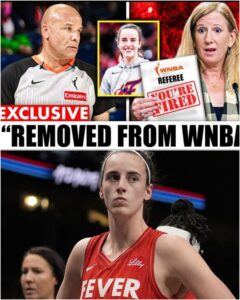They say sports are supposed to be the last honest thing left in this world, but tonight, the WNBA is facing a storm that threatens to wash away every ounce of trust fans have in the game. The league that has spent years fighting for respect, for eyeballs, for the right to be taken seriously on the world stage, now finds itself at the center of a scandal so explosive it feels ripped straight from the pages of a Hollywood script. But this isn’t fiction. This isn’t some Netflix docudrama. This is real, and it’s happening right now, under the harshest spotlight the league has ever known.

It all started in the kind of game that was supposed to showcase everything great about the new WNBA—packed crowds, a surging national audience, and, at the heart of it all, Caitlin Clark, the rookie phenom whose every move has electrified basketball fans coast to coast. The Indiana Fever were locked in a tense battle with the Seattle Storm, and the stakes were high. But as the minutes ticked by, something felt off. The calls weren’t just questionable—they were downright bizarre. Fans at home and in the stands watched in disbelief as whistle after whistle seemed to go against the Fever, and, even more troubling, as obvious fouls against Clark went ignored by referees standing just feet away.
And then, in a moment that’s now been replayed millions of times across social media, Clark drove the lane, was hammered across the face, and crashed to the court. The ref? He watched, stone-faced, arms at his sides. No whistle. No call. Nothing. The crowd erupted in boos. Fever head coach Stephanie White lost it on the sideline, screaming herself hoarse: “You LET her get hurt for what—ratings?!” Clark, clutching her face and blinking back tears, shook it off, got up, and kept playing. But every single person watching knew something had gone terribly, terribly wrong.
What happened next was the kind of behind-the-scenes scramble you only hear about in the aftermath of a disaster. League officials pored over hours of game footage, combed through referee communications, and brought in outside experts to review the tape. What they found was worse than anyone could have imagined: three referees, working in concert, had orchestrated a scheme to tip the game in Seattle’s favor. This wasn’t a case of missed calls or human error. This was a fix, plain and simple. A fix that, by some miracle, didn’t work—the Fever won anyway, their grit and Clark’s sheer willpower overcoming even the stacked deck against them. But the damage was done. The integrity of the league was shattered, broadcast for all the world to see.
The fallout was swift and merciless. The WNBA didn’t just fire the refs—they slapped each with a $500,000 fine, an eye-watering sum in a league where player salaries often don’t even reach that number. But the league’s actions, as bold as they were, felt like a desperate attempt to put out a fire that was already raging out of control. Fans, players, and even sponsors demanded answers. How could this happen? How could the league’s most marketable star be left vulnerable, not just to hard fouls, but to a system that seemed hellbent on breaking her spirit? And what about the whispers—now growing louder—of criminal activity, of money changing hands, of offshore betting interests pulling the strings behind the scenes?
Federal investigators wasted no time getting involved. According to sources, at least one of the disgraced referees accepted payments routed through a shadowy offshore proxy linked to illegal gambling. Suddenly, the story wasn’t just about basketball. It was about wire fraud, about racketeering, about the kind of organized crime that sports leagues have spent decades trying to root out. Insiders described it as a “multi-layered criminal operation disguised as officiating,” and with a federal indictment reportedly just weeks away, the WNBA’s nightmare was only beginning.
Commissioner Cathy Engelbert, usually so measured and composed, took to the podium in an emergency press conference, her voice shaking with equal parts fury and heartbreak. “We are heartbroken. We are furious. And we will not allow our game to be corrupted. This is not just about basketball—it’s about trust.” She promised sweeping reforms: an independent audit of officiating, third-party oversight of replay decisions, and lifetime bans for anyone caught violating the rules again. But the questions kept coming. Why wasn’t this caught sooner? How deep does the rot go? And, most importantly, could the league ever recover from a blow like this?
If there was any doubt about how much this meant to the players, it vanished the moment the story broke. Social media exploded. #FixTheRefs and #JusticeForClark shot to the top of Twitter/X, as players past and present weighed in with a mix of outrage and heartbreak. A’ja Wilson didn’t mince words: “This is sickening. I’m livid.” Sue Bird, a legend in her own right, was just as blunt: “They tried to erase integrity. They failed. But it’s not over.” NBA stars chimed in too, with Tyrese Haliburton reminding everyone, “This isn’t just a Caitlin thing—it’s about every woman in the league. Fix it.” The message was clear: the WNBA’s credibility was on the line, and the world was watching.
And then there was Clark herself. The rookie sensation, the golden girl, suddenly thrust into the center of a scandal that threatened to overshadow everything she’d accomplished. Those close to her say she’s devastated, but determined. She hasn’t spoken publicly yet, but insiders report she’s been staying late at practice, pouring over game film, and preparing for the next matchup as if nothing happened. “She’s not just a star,” one teammate said. “She’s the future. And she’s tougher than anyone gives her credit for.” In a league that desperately needs heroes, Clark refuses to play the victim. She’s bruised, but unbowed, and her next game is expected to draw record-breaking viewership as fans rally behind her.
But the shadow hanging over the WNBA is long and dark. This isn’t just about one game, or even one season. It’s about the soul of the league at a time when it seemed poised for greatness. Caitlin Clark’s arrival had sparked a renaissance—ticket sales soared, merchandise flew off the shelves, and for the first time, the WNBA was the talk of the sports world. Now, all that progress hangs by a thread. Sponsors are nervous. Advertisers are demanding meetings. At least one major broadcast partner is reportedly reconsidering its relationship with the league. The question everyone is asking: Can the WNBA protect its players? Can it protect itself?
Behind closed doors, league officials are scrambling to fast-track a sweeping overhaul of referee protocols before the playoffs. Federal charges could be filed any day now. And as the next nationally televised Fever game approaches, the world will be watching—not just to see how Caitlin Clark performs, but to see whether the league finally has the courage to protect her, and every woman who steps onto that court.
Because this wasn’t just a missed call. This wasn’t just a bad night for the refs. This was a betrayal—a betrayal of the players, the fans, and the very idea that sports can be fair, that hard work and talent are supposed to matter more than anything else. The wound is fresh, the damage is visible, and the league’s most important player nearly paid the price.
As the dust settles and the headlines keep coming, one thing is certain: the next time Caitlin Clark takes the floor, she won’t just be playing for points or for pride. She’ll be playing for the future of the league, for every young girl who ever dreamed of making it big, and for the hope that maybe, just maybe, sports can still be the last honest thing left in this world. The WNBA has been given a second chance—not just to fix its officiating, but to prove that integrity still matters. The whole world is watching. Will the league rise to the moment, or will it let the darkness win? That answer, for now, is still up in the air.
News
Kevin Costner just stepped out post-divorce — and fans can’t stop talking about who he was with. The photos show a softer, unexpectedly sweet side of the Hollywood legend… and one detail has everyone looking twice. Is this quiet companion the key to his next chapter?
Kevin Costner Finds Joy Again — Meet the Puppy Brightening His Days After Divorce Kevin Costner has introduced a brand-new…
CHICAGO P.D. SH0CKER: Key Star Walks Away Before Season 13 and Fans Think It Hints at Something Much Bigger 💥🚨
Confirmed: One Major Star Exits Chicago P.D. Ahead of Season 13 — What This Means for the Unit In a…
Waterfront Star Drops Chilling 5 Word Warning As Season 2 Turns Bl00dy And Viewers Are Sh00k
In the salty, storm-battered coastal town of Havenport, North Carolina, the Buckley family’s fishing empire teeters on the edge of…
😱 Bosch Teams Up with The Lincoln Lawyer in Netflix’s New Must-Watch Crime Saga — Premiering This Fall! 🔥 Two fan-favorite crime worlds collide as Bosch and Mickey Haller join forces in an explosive new Netflix series. With high-stakes investigations, courtroom drama, and street-smart grit, this crossover is shaping up to be the ultimate crime thriller of the year…
Bosch Joins Forces with Mickey Haller in Thrilling New Series Set to Premiere on Netflix This Fall – The Ultimate…
For 18 seasons, Mark Harmon didn’t just play Gibbs—he was NCIS. But what made his role feel so real? Why did fans trust him so deeply, week after week? And how involved was he behind the scenes? Let’s just say… Gibbs wasn’t the only one calling the shots.
Mark Harmon Wasn’t Just Gibbs: He Was the Heartbeat of NCIS for 18 Years For 19 seasons, Mark Harmon didn’t just…
“A new era at Fox News?” — When Aishah Hasnie and Bill Melugin shared the desk for the first time, it didn’t feel like just another segment. It felt like a signal. Young. Sharp. Unshakably composed. Within minutes, the buzz began — not from controversy, but from chemistry. She brought fire. He brought focus. Together, they made Fox News Live feel… new. Fans are calling it “the future of Fox,” insiders are calling it “the smartest move in years,” and one viral comment says it all: “The torch has been passed.” So… is this a one-time experiment — or are we witnessing the rise of the network’s next-generation power duo?..
“A new era at Fox News?” — When Aishah Hasnie and Bill Melugin shared the desk for the first time,…
End of content
No more pages to load












